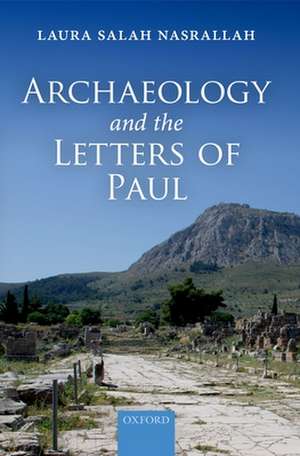Archaeology and the Letters of Paul
Autor Laura Salah Nasrallahen Limba Engleză Paperback – 15 ian 2021
| Toate formatele și edițiile | Preț | Express |
|---|---|---|
| Paperback (1) | 181.86 lei 31-37 zile | |
| OUP OXFORD – 15 ian 2021 | 181.86 lei 31-37 zile | |
| Hardback (1) | 673.92 lei 31-37 zile | |
| OUP OXFORD – 19 dec 2018 | 673.92 lei 31-37 zile |
Preț: 181.86 lei
Preț vechi: 221.45 lei
-18% Nou
Puncte Express: 273
Preț estimativ în valută:
34.80€ • 36.50$ • 28.97£
34.80€ • 36.50$ • 28.97£
Carte tipărită la comandă
Livrare economică 21-27 martie
Preluare comenzi: 021 569.72.76
Specificații
ISBN-13: 9780198842026
ISBN-10: 0198842023
Pagini: 336
Ilustrații: 20 Half-tones; 13 Line drawings
Dimensiuni: 156 x 235 x 20 mm
Greutate: 0.45 kg
Editura: OUP OXFORD
Colecția OUP Oxford
Locul publicării:Oxford, United Kingdom
ISBN-10: 0198842023
Pagini: 336
Ilustrații: 20 Half-tones; 13 Line drawings
Dimensiuni: 156 x 235 x 20 mm
Greutate: 0.45 kg
Editura: OUP OXFORD
Colecția OUP Oxford
Locul publicării:Oxford, United Kingdom
Recenzii
An interesting and wide-ranging volume that attempts to bring together work on Pauline epistles and on Greek and Roman archaeology with contributions from recent feminist and post-colonial theory.
I recommend the book: it is filled with data and synthesis and will greatly repay academic students of Paul and the New Testament.
Recommended.
There is much more to all the chapters than a review can present.
The author's voice is poetic and reflective, making this work delightfully more than a typical "archaeology book."...In addition to Nasrallah's erudite presentation of archaeological data, her methodology makes Archaeology of the Letters of Paul recommended and essential reading for people interested in the material and social history of early Christ-beievers.
...this is now the best book I know of on this topic. I expect to use it soon and often in the study and in the classroom, and I would encourage interested others to do likewise.
N[asrallah] writes as a biblical scholar, writing for biblical students and scholars...Overall, N[asrallah] raises good questions that are rarely asked in the way she does
[An] ... interesting, erudite, and distinctive book.
I recommend the book: it is filled with data and synthesis and will greatly repay academic students of Paul and the New Testament.
Recommended.
There is much more to all the chapters than a review can present.
The author's voice is poetic and reflective, making this work delightfully more than a typical "archaeology book."...In addition to Nasrallah's erudite presentation of archaeological data, her methodology makes Archaeology of the Letters of Paul recommended and essential reading for people interested in the material and social history of early Christ-beievers.
...this is now the best book I know of on this topic. I expect to use it soon and often in the study and in the classroom, and I would encourage interested others to do likewise.
N[asrallah] writes as a biblical scholar, writing for biblical students and scholars...Overall, N[asrallah] raises good questions that are rarely asked in the way she does
[An] ... interesting, erudite, and distinctive book.
Notă biografică
Laura Salah Nasrallah is Buckingham Professor of New Testament Criticism and Interpretation at Yale Divinity School and Yale Department of Religious Studies. Her research and teaching bring together New Testament and early Christian literature with the archaeological remains of the Mediterranean world, and often engage issues of colonialism, gender, status, and power. Her publications include An Ecstasy of Folly: Prophecy and Authority in Early Christianity (2004) and Christian Responses to Roman Art and Architecture: The Second-Century Church Amid the Spaces of Empire (2010).
